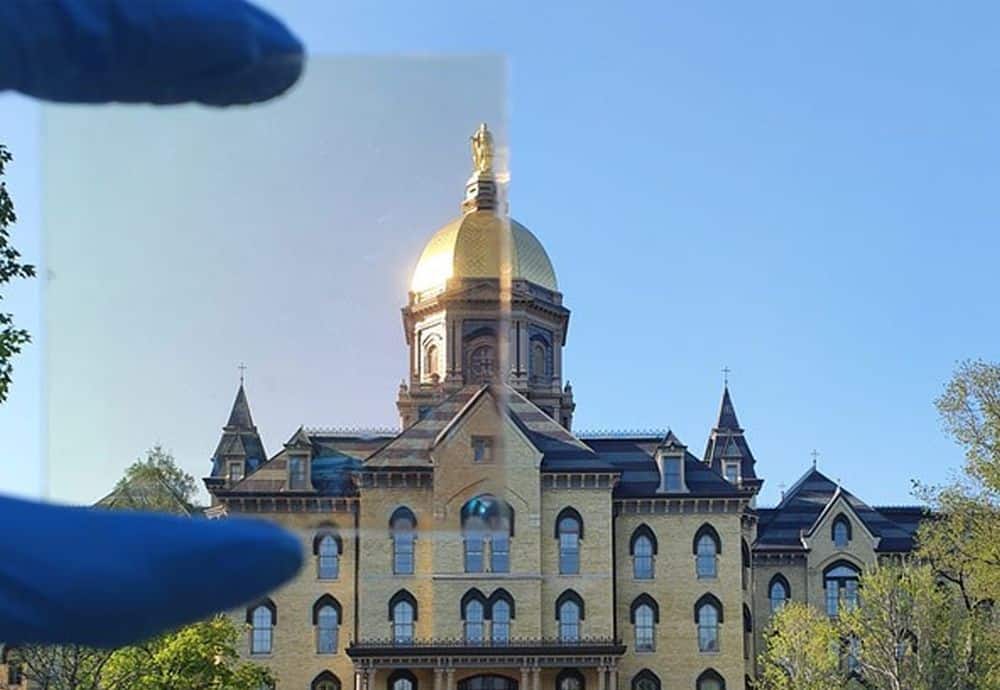
[Image above] Notre Dame’s Golden Dome partially photographed through a sample (left) of the transparent radiative cooling coating for windows. Credit: University of Notre Dame
Just as winters are expected to become colder in the coming years, so too are summers expected to become hotter.
Current air conditioning technology cannot keep up with increasing cooling demands—and will likely exacerbate the warming because of the chemicals used in modern air conditioning units. This situation necessitates not only the development of new air conditioning technologies but also a broader approach to the built environment to reduce the need for air conditioning at all.
Passive radiative cooling is one extensively studied approach to reduce the amount of cooling a building requires. It involves integrating thermally emissive materials into the external structure of a building to dissipate heat into the sky (a natural heat sink). Unlike conventional cooling techniques, passive radiative cooling systems do not consume electricity and do not produce carbon dioxide emissions during operation.
Passive radiative cooling systems typically are implemented by applying special coatings to the walls or roof of a building. However, windows play a significant role in heat transfer within a building, with up to 30% of residential heating and cooling energy use attributed to heat gain and loss through windows.
Some researchers have started investigating the development of transparent radiative cooling materials that can replace conventional window materials, such as here and here. However, developing materials that are both transparent and thermally emissive is a highly nontrivial process.
In a recent study, researchers from the University of Notre Dame in Indiana, as well as a colleague from Kyung Hee University in South Korea, developed a new high-performance transparent radiative cooling material using a quantum computing-assisted active learning scheme.
When people hear the term “quantum computing,” they often think of the gate-based method of quantum computing, which involves creating quantum structures using stable qubits. It is difficult for qubits to maintain stability, however, so this quantum computing method is currently confined to labs and does not yet have practical applications.
In contrast, this study used the quantum computing method called quantum annealing. This method finds the optimal solution to problems involving many solutions by taking advantage of properties specific to quantum physics, such as quantum tunneling.
There are fewer questions to which quantum annealing methods can be applied compared to the very powerful and flexible gate-based quantum computing method. However, it is much easier to build a stable quantum annealing processor and qubits, and so small- and intermediate-scale quantum annealing processors are already starting to be commercially available with today’s technology.
For the current study, the researchers combined quantum annealing with an active machine learning scheme to quickly determine the optimal combination and order of materials for a transparent radiative cooling coating.
The identified optimal transparent radiative cooling coating consists of a 1.2 micron-thick layering of silica, alumina, and titanium dioxide on a silica glass base that is then coated with polydimethylsiloxane (the polymer used in contact lenses).
The researchers write that their new coating outperforms all other heat-reducing glass coatings experimentally demonstrated in the literature, as well as one of the best commercial glasses with a triple-layer silver coating. Overall, their coating could lead to annual energy savings of up to 86.3 MJ/m2 in hot climates compared with normal glass windows.
In a University of Notre Dame press release, senior author Tengfei Luo, Dorini Family Professor of Energy Studies at the University of Notre Dame, says he believes development of the quantum computing strategy was as important as the material itself.
“Using this approach, we were able to find the best-in-class material, design a radiative cooler, and experimentally prove its cooling effect,” he says.
In the future, this quantum annealing-assisted optimization scheme could be used for material design in general, such as metamaterials for optical, thermal, and mechanical applications, the researchers conclude.
The paper, published in ACS Energy Letters, is “High-performance transparent radiative cooler designed by quantum computing” (DOI: 10.1021/acsenergylett.2c01969).
